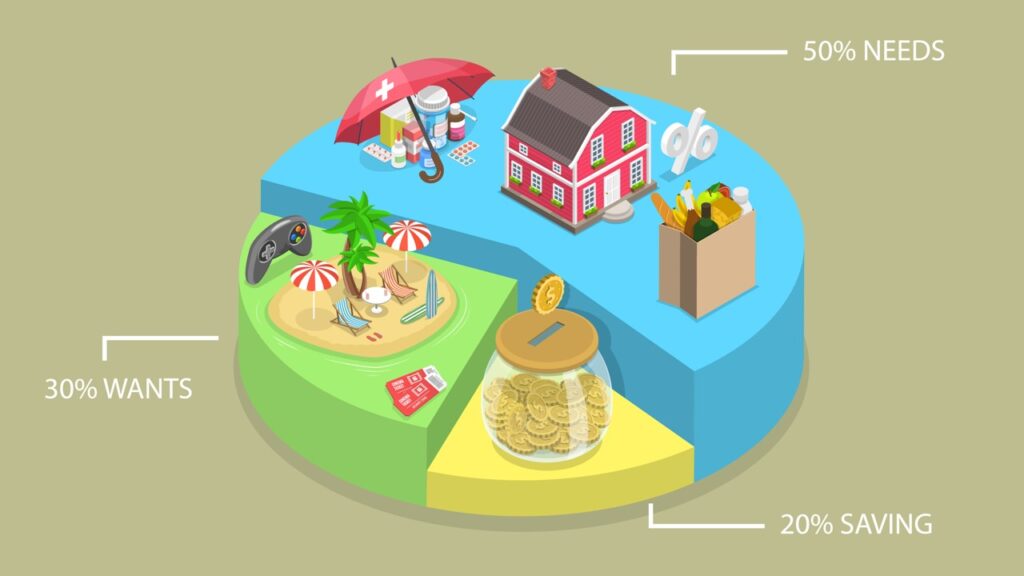A simple and effective way to balance your monthly income wisely.
Understanding what is the 50/30/20 rule can change how you manage money. It’s a clear, structured budgeting method that helps you prioritise needs, wants and savings consistently.
Popularised by US Senator Elizabeth Warren, the rule suggests you allocate 50% of your income to needs, 30% to wants, and 20% to savings or debt repayment.

How to Budget Monthly in the UK
Discover practical and effective ways to organise your income, control your expenses and feel more confident about your finances in the UK.
This formula works because it’s flexible and easy to adapt. Whether you earn weekly or monthly, it offers a starting point that simplifies financial decisions and creates discipline.
In this guide, we explain how the 50/30/20 rule works, how to apply it in the UK, and how to adjust it based on your personal circumstances and goals.
Understanding the Core of the Rule
Before applying the framework, it’s crucial to understand how each category works. The percentages may seem fixed, but the rule’s power lies in its simplicity and flexibility.
Once you define what goes into each portion — needs, wants and savings — you can build a personalised budget that actually supports your financial goals and lifestyle.
What Counts as Needs (50%)
Needs include housing, bills, groceries, transport, insurance, and minimum debt payments. These are essentials — expenses you must pay each month to maintain basic living standards.
This portion of your income should never be ignored. If your needs consume over 50%, look closely at where adjustments can be made, or where you’re confusing needs with wants.
Understanding what is the 50/30/20 rule helps identify and manage these expenses properly. The aim isn’t perfection — it’s recognising what’s essential and making smarter decisions from there.
What Counts as Wants (30%)
Wants are lifestyle extras like restaurants, streaming services, shopping, travel, or gym memberships. They enhance life but aren’t essential — and are the easiest category to adjust.
Spending here should be intentional. Cutting just 5–10% from this section can increase your savings or help manage high fixed costs without a major lifestyle downgrade.
By following what is the 50/30/20 rule, you build discipline around wants. That doesn’t mean cutting joy — it means spending mindfully and ensuring you prioritise long-term security too.
What Counts as Savings (20%)
This category covers savings, investments, and extra debt payments. It’s your future fund — the portion of your income that builds financial freedom, stability, and peace of mind.
If you have high-interest debt, use this category to pay it down faster. Once debts are managed, you can shift toward emergency funds or retirement savings goals.
Applying what is the 50/30/20 rule consistently in this area sets you up for long-term success. Saving becomes a habit, not a leftover, creating real financial momentum over time.
Applying the Rule to Your Budget
Now that you understand the structure, it’s time to apply the rule practically. This means calculating your take-home pay and dividing it according to the 50/30/20 format.
It might not match perfectly at first, and that’s okay. The rule is a guide, not a strict command. Start with what you have and improve monthly.
Calculate Your Net Monthly Income
Start with what you take home after tax and National Insurance. This is your real budget base — not your gross salary or hourly rate.
Once you know your net income, applying what is the 50/30/20 rule becomes much easier. It’s about managing real numbers, not estimates or assumptions.
Divide and Assign Categories
Break your income into three parts: 50% for needs, 30% for wants, and 20% for savings or debt. You can use a spreadsheet or budgeting app to track.
Assign common expenses to each category. Once it’s all sorted, you’ll gain a clearer picture of where money goes — and where it might be leaking unnecessarily.
Adjust Based on Your Lifestyle
Living in London? Rent might exceed 50%. That’s okay — offset it by reducing wants or increasing income. The goal is balance, not perfection.
Adaptation is key. If your financial priorities shift, adjust your budget too. Mastering what is the 50/30/20 rule is about personalisation, not restriction.
Challenges and Solutions in Real Life
Applying this rule sounds easy, but reality can be complex. Let’s explore common obstacles and how to adapt the method when your income or expenses don’t fit perfectly.
The goal is to make the rule work for you, not against you. Progress is better than perfection when building better money habits.
High Fixed Costs
In major UK cities, rent and bills often exceed 50% of income. This squeezes other categories and makes ideal budget percentages feel unrealistic or stressful.
Use the structure of what is the 50/30/20 rule as a baseline, not a rulebook. Reduce lifestyle spending or reclassify debt payments to create a version that works for you.
Irregular or Freelance Income
Freelancers and gig workers face unpredictable cash flow. It’s harder to apply fixed percentages when your monthly income changes — sometimes dramatically — from one cycle to the next.
Use income averages from the past three months as your base. Budget conservatively, prioritise essentials, and adjust each month as new income information becomes available.
Unexpected Expenses
Emergencies or irregular costs like car repairs can disrupt your monthly budget. In these cases, pause wants or reallocate savings to cover temporary gaps.
An emergency fund makes a big difference here. Planning for the unpredictable is part of applying what is the 50/30/20 rule in the real world.
Tools and Strategies to Stay Consistent
Consistency is more important than accuracy. Even if your numbers don’t always match the rule perfectly, regular effort will create lasting habits and progress.
There are plenty of tools and systems to help you stick to the rule over time — and turn it into a natural part of your financial routine.
Use Budgeting Apps with Custom Categories
Budgeting apps allow you to create categories that match your personal goals and lifestyle. They simplify tracking and make progress feel visual, not just mathematical or abstract.
When using these tools, it becomes easier to follow principles like what is the 50/30/20 rule by assigning exact amounts and getting real-time alerts when you overspend.
Create a Monthly Buffer Zone
A flexible buffer — separate from savings — helps cover small surprises without ruining your entire budget. It adds breathing room, especially in months with unpredictable expenses.
You can build this buffer gradually by rolling over unused amounts. Think of it as your “mistake cushion,” allowing you to learn without starting from zero every time.
Reflect on Spending Trends Monthly
Set aside time each month to analyse where your money went. Reviewing categories helps spot patterns and improve how you apply budgeting frameworks in the future.
Even when using systems like what is the 50/30/20 rule, real-world adjustments are necessary. A regular review turns numbers into knowledge and reinforces better decisions over time.
Stay Motivated with Visual Progress
Progress bars, charts, or goal trackers keep budgeting exciting. They provide motivation to stick with it — especially when financial goals feel distant or overwhelming.
Celebrating milestones, like three months of consistent saving, boosts confidence. Seeing your results clearly turns budgeting from a chore into a long-term habit you’re proud of.
Also Read: Use Budgeting Apps to Make It Easier
The 50/30/20 rule is powerful, but using the right tools makes it even easier. Budgeting apps provide automation, alerts and visual breakdowns of your spending patterns.
If you’re ready to build a more efficient and consistent budgeting habit, integrating tech support can be your next smart move.
These tools are especially useful if you struggle with manual tracking, irregular income, or just want to stay motivated with real-time insights.
Check out our article Best Budgeting Apps for 2025 and find the right platform to simplify your routine and boost the impact of the 50/30/20 rule.

Best Budgeting Apps for 2025
Find the perfect app to take control of your finances, reduce overspending and make money management easier than ever before.

